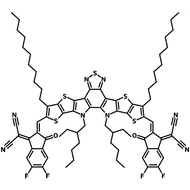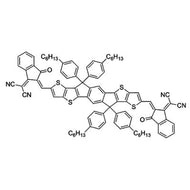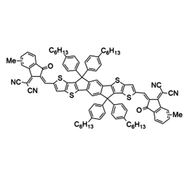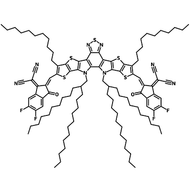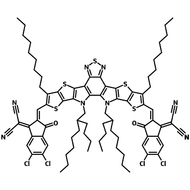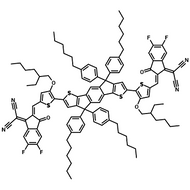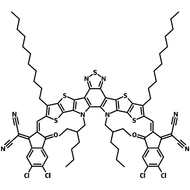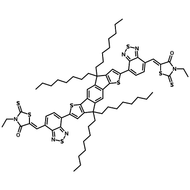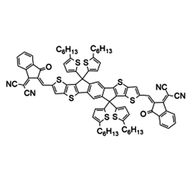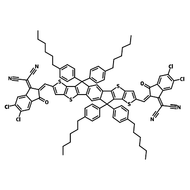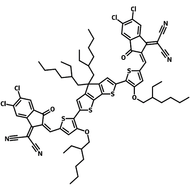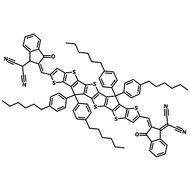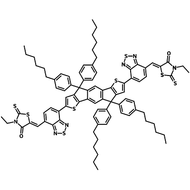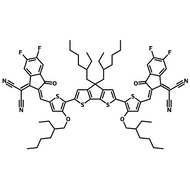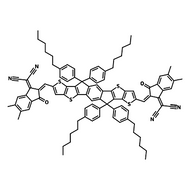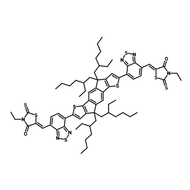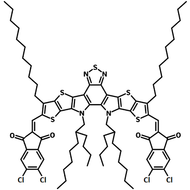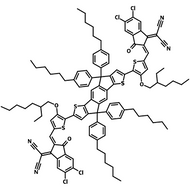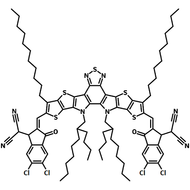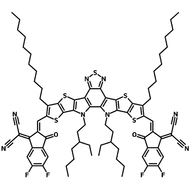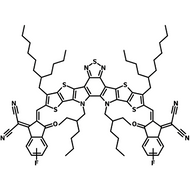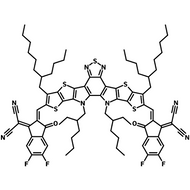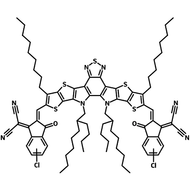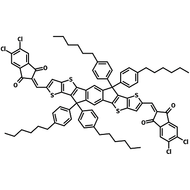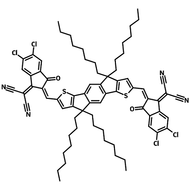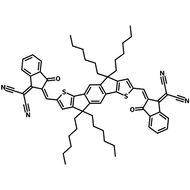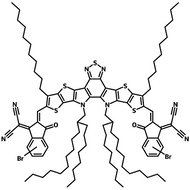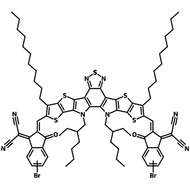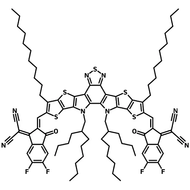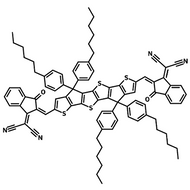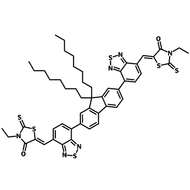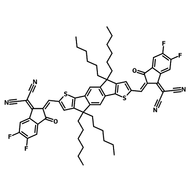ITIC-4F, high performance acceptor molecule
Non-fullerene acceptor with broad absorption spectrum, 99% purity
Part of our range of non-fullerene acceptors (NFAs), ITIC-4F (also known as ITIC-2F or IT-4F), CAS number 2097998-59-7, is a derivative of ITIC. Compared to ITIC, ITIC-4F has a better absorption coefficient and a more red-shifted absorption. This can be ascribed to enhanced intramolecular charge transfer. Devices which use ITIC-4F as the electron acceptor can therefore cover a broader absorption spectrum, which may result in a better power conversion efficiency (PCE).
ITIC-4F also has deeper HOMO/LUMO energy levels than ITIC. This makes it a better match for most polymer semiconductor donors, and provides better stability for device fabrication and overall performance. Using an inverted device structure (indium tin oxide (ITO)/ZnO/PBDB-T-SF:TI-4F (1:1)/MoO3/Al [1]), an efficiency of over 13% has been achieved using ITIC-4F as the non-fullerene acceptor and the polymer PBDB-T-SF as the active-layer donor material.
High efficient non-flullerene acceptor
with highly conjugated core
Better absorption coefficient and red-shifted absorption
With enhanced intermolecular charge transfer
Worldwide shipping
Quick and reliable shipping
High purity
>99% High purity
ITIC-4F from Ossila was used in the high-impact paper (IF 18.81), Stretchable and Transparent Conductive PEDOT:PSS-Based Electrodes for Organic Photovoltaics and Strain Sensors Applications, E. Dauzon et al., Adv. Fun. Mater., 30 (28), 2001251 (2020); DOI: 10.1002/adfm.202001251.
Our range of non-fullerene acceptors for highly efficient organic solar cells also includes ITIC and ITIC family members ITIC-DCl, ITIC-M, ITIC-Th, and ITIC-DM. Qualifying orders ship free and all orders are covered by the Ossila Guarantee.
Characterisation (1H NMR)

Chemical Structure

Literature and Reviews
- Molecular Optimization Enables over 13% Efficiency in Organic Solar Cells, W. Zhao at al., J. Am. Chem. Soc., 139 (21), 7148–7151 (2017); DOI: 10.1021/jacs.7b02677.
- Energy-Level Modulation of Small-Molecule Electron Acceptors to Achieve over 12% Efficiency in Polymer Solar Cells, S. Li et al, Adv. Mater., 28, 9423–9429 (2016); DOI: 10.1002/adma.201602776.
General Information
| CAS Number | 2097998-59-7 |
| Chemical Formula | C94H78F4N4O2S4 |
| Purity | 99% (1H NMR) |
| Full Name | 3,9-bis(2-methylene-((3-(1,1-dicyanomethylene)-6,7-difluoro)-indanone))-5,5,11,11-tetrakis(4-hexylphenyl)-dithieno[2,3-d:2’,3’-d’]-s-indaceno[1,2-b:5,6-b’]dithiophene |
| Molecular Weight | 1499.90 g/mol |
| HOMO / LUMO | HOMO = -5.66 eV, LUMO = -4.14 eV [1] |
| Synonyms | ITIC-2F, ITIC-F, IT-4F, ITIC-DF, IT4F |
| Classification / Family | NFAs, organic semiconducting materials, low band-gap small molecule, small molecular acceptor, organic photovoltaics, polymer solar cells, NF-PSCs, n-type acceptor |
MSDS Documentation
Pricing
| Batch | Quantity | Price |
| M2075A1 | 50 mg | £210 |
| M2075A1 | 100 mg | £320 |
| M2075A1 | 250 mg | £640 |
| M2075A1 | 500 mg | £1050 |
| M2075A1 | 1 g | £1900 |
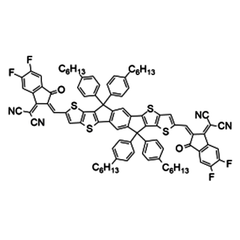
 ITIC-4F (ITIC-2F) MSDS Sheet
ITIC-4F (ITIC-2F) MSDS Sheet